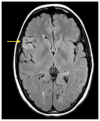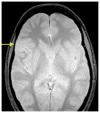Dysembryoplastic neuroepithelial tumor with atypical presentation: MRI and diffusion tensor characteristics
- PMID: 24421925
- PMCID: PMC3888338
- DOI: 10.3941/jrcr.v7i11.1559
Dysembryoplastic neuroepithelial tumor with atypical presentation: MRI and diffusion tensor characteristics
Abstract
We report the neuroimaging findings of a 26-year-old female patient with a biopsy-proven dysembryoplastic neuroepithelial tumor (DNET). DNETs are an uncommon, usually benign, glial-neural cortical neoplasm of children and young adults who typically present with intractable seizures. DNETs may occur in any region of the supratentorial cortex, but have a predilection for the temporal lobes. Accurate neuroimaging diagnosis is essential since patients with DNET benefit from complete resection. However, accurate differentiation from other cortical lesions may be challenging. Typical conventional Magnetic Resonance Imaging (MRI) features can help in the differentiation from other similar cortical tumors. Diffusion tensor imaging can also provide important additional diagnostic information regarding the degree of involvement of adjacent parenchyma and white matter tracts. In this case, tractography and fractional anisotropy maps demonstrated that fiber tracts surrounding the lesion were displaced, but fiber integrity was maintained, which is more suggestive of a DNET rather than a more aggressive neoplasm. Accurate identification of DNETs is essential for the purpose of rendering a timely diagnosis and start appropriate treatment.
Keywords: Diffusion tensor imaging; Dysembryoplastic neuroepithelial tumor (DNET); Neuroimaging; Tractography.
Figures







References
-
- Daumas-Duport C, Pietsch T, Lantos PL. Dysembryoplastic neuroepithelialtumour. In: Kleihues P, Cavenee WK, editors. Pathology and genetics of tumours of the nervous system. Lyon, France: IARC; 2000. pp. 103–106.
-
- Cervera-Pierot P, Varlet P, Chodkiewicz JP, Daumas-Duport C. Dysembryoplastic neuroepithelial tumors located in the caudate nucleus area: report of four cases. Neurosurgery. 1997 May;40(5):1065–1070. - PubMed
-
- Frater JL, Prayson RA, Morris HH, Bingaman WE. Surgical pathological findings of extratemporal-based intractable epilepsy: a study of 133 consecutive resections. Arch Pathol Lab Med. 2000 Apr;124:545–549. - PubMed
-
- Kuroiwa T, Kishikawa T, Kato A, Ueno M, Kudo S, Tabuci K. Dysembryoplastic neuroepithelial tumors: MR findings. J Comput Assist Tomogr. 1994 May-Jun;18(3):352–356. - PubMed
-
- Parmar HA, Hawkins C, Ozelame R, Chuang S, Rutka J, Blaser S. Fluid-attenuated inversion recovery ring sign as a marker of dysembryoplastic neuroepithelial tumors. J Comput Assist Tomogr. 2007 May-Jun;31(3):348–353. - PubMed
Publication types
MeSH terms
LinkOut - more resources
Full Text Sources
Other Literature Sources
Medical

